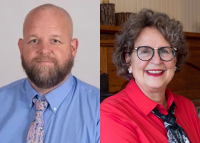A tax break for one business is not a plan
Before Haywood County commissioners approve a request to cut property taxes on a business that plans to build an $8 million solar farm near Canton, they need to get serious about developing a long-term green collar industry incentive package. One break for one company seems more like a handout, which in this day every other company could find fault with.
On the surface the request seems almost inconsequential given the relatively small amount of money involved, about $32,000 over five years. In this economy, however, many will be watching the commissioners very closely. A whole lot of local, long-time businesses are struggling to keep people employed while paying their taxes in full.
FLS Solar Energy is planning what is billed as the largest solar farm in the Southeast on an old landfill in Canton. It will install 3,200 solar panels on seven acres that will produce enough electricity to power 1,200 homes. The company has signed a 20-year agreement to sell the electricity to Progress Energy. The utility giant must, under state law, start producing an increasing percentage of its power from green sources.
The announcement late last year that Haywood would be chosen for the solar farm was met with near universal excitement. Although the project won’t produce any long-term jobs, it is being hailed as a coup for Haywood County and Western North Carolina. Row upon row of solar panels will track the sun from an old landfill, proving that this region cares about energy production and global warming, perhaps providing some intangible benefits when it comes to business recruitment. It’s difficult to gauge the economic development benefit of having the largest solar farm in the Southeast (though it’s likely a larger facility somewhere won’t be far behind), but most believe that benefit is more symbolic than tangible.
FLS, for its part, is asking for help to make it through its first five years in opration. The $32,000 it wants Haywood County to forgive amounts to 80 percent of its business property taxes for the first five years it is in operation.
But here’s the rub: even though the request has the endorsement of the county Economic Development Commission, it doesn’t meet existing criteria for the tax break. Specifically, to get the 80 percent tax break the county’s guidelines say the project needs to create 100 jobs and have an investment of at least $10 million. This project is expected to employ 12 as it’s built and no one after it is up and running, and it already qualifies for the federal government’s 30 percent solar energy tax break.
Projects like this are appealing for many reasons, one of which is the “coolness” factor. That line of thinking says if you support green projects, you are cool and everyone will want to join in. But that’s a weak foundation for county policy.
If Haywood wants to become an epicenter of green energy and environmentalism, giving a one-time handout to a solar farm won’t get it there. Instead, county leaders need to develop an array of tax breaks, grants and incentives for new businesses engaged in green technology and for existing businesses that become energy efficient and recycle. In this case the fact that old landfill property is being used is probably more significant than the solar energy aspect of the project.
The green initiative being led by Haywood Community College President Rose Johnson and flourishing under the auspices of HCC and the Haywood County Chamber of Commerce should be encouraged and embraced. The county’s effort to get methane energy from the old landfill is also worth touting. The role of the Commission for a Clean County should be expanded and officially endorsed by the county.
Yes, Haywood County could benefit immensely by becoming a leader in all things green, and businesses and people in the mountains have been embracing this philosophy for decades. But there is a competition out there. Local governments across the nation are also trying to grab this mantle. Haywood needs a long-term plan and a real investment to get there. Helping this company might be symbolic of where the county wants to go, but approving this tax break isn’t really all that progressive. In fact it is simply applying an old-style economic development model to a new industry.
We wish FLS great success, and solar energy is a crucial component for meeting future energy needs. From Haywood County’s perspective, however, approving this tax break at this time is like putting the cart before the proverbial horse.
(Scott McLeod can be reached at This email address is being protected from spambots. You need JavaScript enabled to view it..)
A community can provide real help to those in need
By Marsha Crites • Guest Columnist
It occurred to me as I was hiking up my mountain today that one of the reasons Obama’s “Yes, We Can” slogan may have resonated with so many is that it sounds a bit like the message from our childhood book The Little Engine That Could. In that timeless story, the engine, who had been ridiculed by the newer shinier trains, keeps repeating the mantra, “I think I can, I think I can, I think I can,” until he crests the hill and sings, “ I thought I could, I thought I could, I thought I could.”
The hill we are climbing as a nation right now is incredibly steep. Suffering is all around and seems to spare few businesses or individuals. The morass we have created (yes, most of us have contributed in some small way to the financial mess) is thick. Even the smartest among our leaders will struggle to make the right decisions about what will get us to the top of the hill fastest. I wonder sometimes whether those solutions that are the quick fixes will really be the long-term solutions we need. Indeed, the Little Engine in the story traveled slowly, slowly and precariously, using mainly will power to make it to the top.
If we were really lucky we had parents who could read us that story, who could encourage us when the challenges of childhood seemed insurmountable, who modeled determination and optimism in their own life struggles. But many of us did not have such models. Those who were raised in homes where addiction, abuse, neglect, mental illness, and racism played a large role are likely to suffer more now, as the tools of resilience and perseverance were not available to them in those critical developmental years.
Yet, most of us know at least one person who by force of sheer determination overcame great obstacles to enjoy a better life. I am not necessarily talking about financial obstacles or success here. We all know someone who suffered great losses, unbelievable physical or mental illness, the collapse of all they held dear, and went on, like the phoenix rising from the ashes, to re-create themselves in a powerful and fulfilling way.
I am fortunate in many ways to have worked though Haywood Community College this winter to help provide skills and encouragement to the unemployed, including those incarcerated in prison. Imagine, if you will, preparing to leave prison in this economy. Where will they find shelter, a job, food, and the encouragement they will need to start over, when even those without a record are struggling?
Yet, I seriously believe that those leaving prison have something many of us don’t. Many prisoners have faced their own “bottom,” as they say in the world of recovery from addictions (and the state we keep hoping for in the stock market). They have lost everything and must begin again with a rusty engine and determination to build a whole new life. These folks have a powerful incentive to get it right this time.
But we, as a community, must be willing to offer them the chance, to support their struggles to build stronger families, to learn new skills, to get a job, to be more effective parents and choose new ways of coping with the challenges we all face. It is tempting to judge these folks as people who don’t deserve a second chance. But who among us will cast the first stone?
Look around you in Western North Carolina and you will see lots of miracles taking place. In both Haywood and Jackson counties, in the last two or three months, social service agencies, churches, and other volunteers have opened shelters for the homeless within weeks of determining the need. Folks who have never planted gardens are ordering seeds and waiting eagerly for enough warmth to turn over the earth. People who have never checked on their neighbors are offering a hand with cutting wood, or sharing food.
Without this financial mess, we, as a nation, did not have the fortitude to take on the greed and corruption rife in many of our industries and governmental bodies. We, too, now have the opportunity, like those getting out of prison, to begin again with a new set of ethics. We can hold accountable those institutions that serve us and for whom we work, accountable to the standards of honesty and transparency, servant leadership, justice and accountability. We an insist that as individuals and organizations we stop the thoughtless dependence on fossil fuels. We cab begin to green up our own lives. And we can insist that our food sources be really safe and sustainable.
It will be easy once we are on the down side of the financial mountain to return to our passive neglect of our responsibilities as citizens, just as it will be easy for those leaving prison to return to the addictions and habits that got them into trouble in the first place.
But I, too, have a dream. I dream of a day in the not too distant future, when we can all find honest work for safe and thoughtful companies whose real values play out in more than a slogan on the wall. When all our children have someone to read them The Little Engine That Could. When we have conquered the scourge of addiction and mental illness, problems that cause far more suffering than cancer or heart disease. When we have access to clean fuel and healthy food sources. When businesses understand like our animal brethren, that fowling our nest just doesn’t pay.
If you are among the down and out right now, I encourage you to practice what cultures in the Far East call mindfulness. Whether you are incarcerated, laid off, discouraged, or panicked about our current state of affairs, there are some simple tools that will see you through. In the face of an uncertain future, decide to be present now. Most of us don’t breathe deeply. It really works. Commit to reading to a child daily (start with The Little Engine That Could), make a list first thing in the morning or last at night of all the things you are personally grateful for, play your guitar or piano if you can, bring in daffodils to grace your table. Work at the homeless shelter, go to the library and read an inspiring book, walk or run outside every day, turn off the scary news, take out food from your freezer and cook a heart- and belly-warming soup. Share your wood, your food, your time, and your fledgling hope with those around you. Sing loudly in the shower even if you don’t feel like it.
I promise you that those of us who take this path will see an end to our personal recession sooner than those who sit in front of the TV regretting our pasts and fearing our futures.
A caveat here. If the dark night of the soul you are experiencing is real clinical depression, no amount of music, daffodils, or helping your neighbors will be meaningful, because people who are clinically depressed cannot smell, feel, or hear that which is beautiful or inspirational. If you suffer from clinical depression this is a great time to get or stay on professionally prescribed medicines. If you lack access to medical care seek help for your depression through Smoky Mountain Center or the Good Samaritan Clinic.”
Meanwhile, remember The Little Engine That Could — I think I can, I think I can, I think I can .... I thought I could.
(Marsha S. Crites is owner of Harvest Moon Gardens in Jackson County. She is a part time faculty at HCC and also is a teacher/instructor with Moonshadow Learning Services. She can be reached at This email address is being protected from spambots. You need JavaScript enabled to view it..)
Mr. February, me and my wife make happy
I love dogs. Except during that period in my life when I lived in a seemingly endless series of shoebox apartments that did not allow pets larger or furrier than goldfish, I have always had at least one dog, and usually two. I have seen a good many dogs come and go in my life, but I have never, ever actually bought a dog. With so many dogs in shelters, it is simply against my principles. All of my dogs have been either shelter dogs or strays I found out roaming around.
But I’ll tell you something I’ve learned: There are principles, and then there is marriage. If you are not married, then you may not know this — I didn’t — but marriage has its own principles that may not always snuggle up cozily to your own. If you do not grasp this basic truth, you will one day wind up in the doghouse with your shelter dog and your precious principles for company.
Now my wife is not an acquisitive person and not really an animal person either — let’s just say she is more tolerant of our pets than doting and leave it be — but for years, she has fancied dachshunds, especially miniature dachshunds. If we are driving down the street and she sees one in a neighbor’s yard or on a leash, she falls into paroxysms of pure schoolgirl joy, the way schoolgirls used to get over catching an unexpected glimpse at David Cassidy in Tiger Beat. If my wife were still a schoolgirl, I guess she would go crazy over the Jonas Brothers, but since she is married with kids, a job, a mortgage, and a minivan with a window that will roll down but not back up, her passions have shifted. Teen idols are out, miniature dachshunds are in.
So I did the right thing and got her a miniature dachshund calendar for Christmas. I thought it was the perfect compromise for someone who loved the breed, but already had one dog, one cat, two gerbils, two children, and one husband on her hands. She could look at dachshunds every day of the week, every month of the year, and never have to feed one, clean up after it, take it to the vet, or complain that it had been gnawing on her best work shoes. She would have her daily quota of dachshund cuteness, without any poop or barking. Pretty good deal, I thought.
But there are the things you think, and then there is marriage, and these things do not always sit comfortably together in the same carriage on the Ferris Wheel. In other words, she did like the calendar — it hangs in our kitchen now, where every single day one of 12 adorable dachshund puppies will supervise one of us making breakfast or washing the dishes until the year is up. If I thought this would cure her puppy fever, however, it didn’t take long to see that it had just the opposite effect. With a cute dachshund staring her in the face every day — Mr. February was especially adorable, I must admit — my wife suddenly could no longer contain herself.
All I’ve heard for two solid months is “dachshund this” and “dachshund that.” She manages to work dachshunds into every conversation, regardless of how ill fitting it may seem to anyone not quite so dachshund-centric. Yes, it is true that we may be able to get another 50,000 miles out of the minivan, but how many miles would we get out of a brand new miniature dachshund puppy? Sure, she has seen the brochures that came from Florida, and maybe we should go there for vacation this summer, but have I imagined how great it would be to see a dachshund puppy encountering the ocean for the first time?
After several weeks of this, I knew what had to be done, so on Monday, we just did it. We found an adorable miniature dachshund puppy for sale online, and made arrangements to meet the owners in Asheville to “look him over.”
“We can just look,” my wife said. “We don’t have to buy him.”
Well, there are the things you don’t have to do, and then there is marriage. Needless to say, these things don’t always drink out of the same water dish. I grabbed the checkbook and we were off.
We met the owners at Alan’s Pawn and Jewelry, and within two minutes after we pulled into the parking lot, my wife had the puppy in her hands. He was six weeks old, the runt of the litter. He was unbelievably tiny, a cigarette lighter with short legs and floppy ears, a Pez dispenser with puppy breath and needle teeth.
He also looked exactly like Mr. February.
You know how this story ends. It ends with a new puppy in your house, chewing on anything he can get his tiny mouth around. It ends with you out in the yard at 4 a.m., watching a shivering puppy do his business in the yard with the moon as the only witness. It ends with your children excited, even delirious, over the arrival of the new “mincer dot son,” as your son calls him.
It ends with your wife doting on the puppy, smiling and happy. When she’s not doting on him, she’s doting on YOU. And why shouldn’t she? You’re a genius. It only took you about three years to figure this out. You congratulate yourself and think about grabbing a quick nap.
You’d better hurry, before Mr. February wakes up from his.
(Chris Cox is a writer and teacher who lives in Waynesville. He can be reached at This email address is being protected from spambots. You need JavaScript enabled to view it..)
Tough year for HRMC teaches hard lessons
It’s a cultural tradition in nearly every society, the firm belief that people and institutions become stronger once they’ve been tested. Whether that test comes about due to one’s own shortcomings or to circumstances outside one’s control is important, but in the end it’s the outcome that we remember.
So it is with Haywood Regional Medical Center. When its Medicaid and Medicare status was lost just over a year ago and the hospital went into a financial freefall, people were angry, upset and felt betrayed. They were also very worried that the place they considered their number one healthcare option was in real jeopardy of closing down and that many friends and neighbors would lose their jobs.
In hindsight, that extreme emotional attachment to HRMC might have been its saving grace. County leaders, physicians, hospital staff, and a whole lot of concerned citizens stayed with HRMC when it might have been easier to let it sink. When the number of patients going to the hospital on a daily basis sank to single digits, inspectors still hadn’t given their final OK for re-certification, and the bank account was close to running dry, closing seemed imminent.
No one knows what corporate shape HRMC will finally take — affiliation with another hospital system and with WestCare seems certain, but the structure of that affiliation is still unknown — but now no one believes that Haywood County won’t have a hospital, which seemed a very real possibility in early March of 2008.
So what from this past year at HRMC should residents remember?
First and foremost is the responsibility that lies with the hospital’s board of trustees. These dedicated citizens who volunteer their time must be vigilant to strike a balance between the sometimes competing interests of hospital administrators and the medical staff. They must also be able to look beyond those personal and professional relationships to keep in mind the hospital’s value to the community. No person or group is more important than the institution. It’s a balancing act, but if trustees tip too far one way — as happened with the previous board’s almost blind allegiance to former CEO David Rice — bad things can happen.
Secondly, and probably just as important, is the wisdom and dedication of the long-time members of the medical community. When the medical staff asked some doctors to speak to the board of trustees at a December 2006 meeting, they pointed out very clearly that the relationship between the administration and the medical staff had become dysfunctional. The board, however, ignored those pleas.
Among those to speak at that meeting — where a well-liked ER group was about to be fired — were Dr. Henry Nathan, Dr. John Stringfield and Dr. Benny Sharpton, three of the county’s most respected physicians. HRMC’s medical community, by and large, are practicing medicine for the right reasons and need to be listened to.
Lastly, and like it or not, the CEO of a small hospital carries a lot of power. That can be either beneficial or detrimental, depending on the circumstances. If one went to Raleigh or Charlotte, the CEO of a large metro hospital might get lost among the thousands of employees, hundreds of doctors, and dozens of administrators. Not so at a hospital like HRMC. Former CEO David Rice was very powerful and became very polarizing, yet his strength of personality blinded those who should have seen his shortcomings.
HRMC’s new CEO Michael Poore will also wield a lot of influence. He has become the new face of HRMC, an affable, intelligent guy that has best been described as a “breath of fresh air.” Most believe he will serve the hospital well, and already he is restoring credibility both internally and in the community.
HRMC has survived and, perhaps, become stronger because of this crisis. It might not be so lucky if an event of this magnitude ever occurs again, a truth that should serve as a cautionary reminder to those who might too quickly forget the events of the past year.
Jackson library deserving of community support
Deduction would tell us that in the information age libraries would be accorded great respect, but somehow that isn’t universally the case anymore. Given that truth, it’s encouraging to see what has happened over the last several years in Jackson County as support has gathered for a new library that, after much debate, will be attached to the strikingly beautiful historic courthouse.
After a decade-long community debate that raged with unusual fervor, county leaders decided in October 2007 to put the county’s new library atop courthouse hill. This wise decision did two things: ensured Jackson County residents their new, much-needed library would have wide community support; and it infused the project with a historic and cultural significance, providing a symbol of political and intellectual aspirations that will endure for generations.
There was a time when libraries were enshrined as the world’s primary learning centers. The administrators of the ancient library of Alexandria, Egypt, according to some historians, were charged with with no less a task than bringing together all the world’s collective knowledge. Stipends were paid to scholars and their families to come spend time there. Throughout the ancient world libraries were held in high regard as the keepers of culture and history, and typically they were among a city’s most splendid architectural masterpiece.
Today too many communities neglect these important institutions. As television and the Internet have grown in significance, and indeed put much of the world’s knowledge and literature at our fingertips, libraries could be written off as quaint relics.
But that’s just not the case. Places where people — children and adults — gather to read, write, research and discuss ideas will always be important. Amid the rush of today’s world, a place where adults work and read in a cocoon of silence and where children can discover the profound joys of the written word are indeed sacred.
Macon County has already done its community proud with its recently opened library, and citizens came together to support the furnishings of that facility with their donations. Now the same is being asked of Jackson County residents. Fund raising is currently under way, and almost $500,000 of the $1.6 million goal has already been pledged.
We believe this library is among the most worthy of community projects. It will become the epicenter of the intellectual and community life of Jackson County, and we encourage residents to support the fund-raising drive to the best of their abilities.
For young illegals, a coming-of-age quandary
Irene is not just a good student. She is one of the very best at her school, near the top of her class and hard working as they come. Under ordinary circumstances, she would be filling out applications to the University of North Carolina at Chapel Hill, Duke, Wake Forest, and other top universities. She would be competing for prestigious scholarships.
She would be visiting these campuses and talking over her options with academic counselors, comparing programs and getting a feel for what her life might be like in these different settings. It would be one of the most exciting times of her life. Having put herself in the enviable position of being able to pick and choose among excellent universities as a result of her extraordinary work and commitment to her education and future, she would have the whole world at her doorstep.
There is never again a time in person’s life quite like being 17 or 18 years old, especially for someone like Irene, a student with the potential and drive to do or be almost anything she wants to be. If the election of Barack Obama meant anything, it meant that the American Dream really does exist.
Unlike our most recent president, Obama was not born with a silver spoon in his mouth, did not have every break and advantage handed to him along the way. He came from a very poor background, but he worked hard, never letting the challenges of his childhood or the negative stereotypes about his ethnic heritage prevent him from accomplishing his goals as a student. Not only did he attend Harvard Law School, he was the first black student to ever become president of the Harvard Law Review. Now he is President of the United States. His story is an affirmation of what is possible if a person is only determined enough to succeed.
All of this stands as an inspiration then, for Irene? Well, no. In fact, it is a pill perhaps even more bitter to swallow. The one thing Irene cannot do, regardless of how hard she works or what she accomplishes in high school, regardless of how highly her teachers think of her or how bejeweled her academic record may be, is to make herself an American citizen. She cannot change the circumstances of her birth, or account for the decisions her parents made.
And what decisions are these, exactly? To come to America to find a better life? To work hard and earn a place of respect in the community? To open a restaurant and feed people? To send their children to a better school?
The issue of illegal immigration has been hotly debated, and people of good will can certainly disagree about it. Unfortunately, the debate has not always been waged by people of good will; we have all seen depressing examples of how quickly bigotry can be introduced into the equation. “Those people” are coming here to take our jobs, spreading their diseases and lowering the quality of life wherever “they” go. Yes, depressing, the ignorance and the hatred that so often goes with it.
Still, the issue remains, and it is a serious issue that must be addressed by serious people, not the louts who typically dominate public discourse with their shrill voices, sharpened to a point by the whetstone of talk radio. That’s all well and good. In the meantime, what I want to know is this: What about Irene?
Irene should be filling out applications to the best universities in the state, but she isn’t. She cannot, because while she has a grade point average that very few students can match, she does not have what even the laziest, least ambitious students all have: a social security number. Without one, she has no realistic shot at getting into any of those schools. The very best she can hope for is to get in, and then have to pay out-of-state tuition, which so far exceeds in-state tuition rates as to make it impossible to even consider, especially since she cannot compete for any scholarships.
Under ordinary circumstances, her achievements in high school would have brought her to the beginning of something bigger, perhaps much bigger. That would be up to her, because in America, as Barack Obama has proven, you can be anything if you work hard enough and believe strongly enough in yourself and your future.
But these circumstances are not ordinary, even if they are not unique. Irene may not be the only child of illegal immigrants to excel in high school, and not the only one with the potential to achieve wondrous things at our finest universities. And yet, there she is, at the door, which, for her, is locked.
Whether we agree or disagree about illegal immigration, there are fundamental questions that go much deeper than the issue itself, especially in the abstract. If an illegal immigrant appears at the hospital so badly in need of treatment that death is a real possibility, would we choose to ignore it and let him die? If a student does everything in her power to achieve the American dream, are we going to deny her the chance that any of our sons and daughters would have? Remember, even if you have little sympathy for what her parents chose to do, Irene did not make that choice.
Adversity teaches us things about ourselves, sometimes things we might just as soon not learn. In these bad economic times, when so many are suffering, it is all the more likely that anger toward illegal immigrants will be ginned up. The question is, even in tough times like these, do we really want to live in a country callous enough to say “No, you can’t” to Irene?
President Obama’s mantra before the election was “Yes, we can.” I sincerely hope Irene is part of “we” and not just another one of “those people.”
(Chris Cox is a writer and teacher who lives in Waynesville. He can be reached at This email address is being protected from spambots. You need JavaScript enabled to view it..)
Free clinic plugs mental health holes
By Marth Teater • Guest Columnist
The Good Samaritan Clinic of Haywood County has served the medical needs of our community since 1999. In 2007 the clinic started a mental health program funded by two multi-year grants. Funding for the program ended in 2008, and the clinic has been utilizing funds from individuals in the community to sustain the program until funds become available.
We have applied for funding from three major grantors, but even if we get those grants, funds will not be available until the summer. Without immediate funding the clinic will be hard pressed to find money to continue the program.
In 2008 the Good Samaritan Clinic provided over 1,400 therapy visits at no cost to the patients. Currently the clinic has two mental health counselors on staff. Both have master’s degrees and several years of experience. The clinic also utilizes volunteer counselors and student interns.
Clinic patients may receive up to eight individual counseling visits with one of the clinic counselors to help improve their mental and physical well-being.
We anticipate serving more than 1,680 patients in 2009. At about $100 per visit, we are providing $168,000 worth of visits per year for $50,400 since our counselors work for a much reduced rate. The savings to our community are significant.
The clinic is supported by area churches, individuals, civic groups, and grantors. Haywood County and the United Way contribute as well. This support helps the clinic to continue to provide medical services to uninsured adults in our county.
“Our general operating funds are not used for the mental health program,” said Donda Bennett, executive director for GSC. “This program operates solely on grant funding and donations.”
Although funds were applied for in early 2009 the clinic will not find out if they are being funded until early June. The only way to continue this program is to appeal to the community for emergency funds.
Current clinic counselors are Art Dosch and Sequoyah Rich. Both are master’s level practitioners with a wealth of experience and a desire to serve those in need. I am the director of mental health services and oversee the counseling program of the clinic.
The counselors work as a team with the health care providers; medical director Don Teater, MD, and Kristin Gruner, PA. This coordination of care has tremendous advantages to more traditional models of care that treat mental and physical health separately.
The clinic has the capacity to provide about 140 client visits monthly, or 1,600 annually. Providing this mental health care benefits the entire community in many ways. By keeping people emotionally stable we will see a reduction in emergency room and urgent care visits, fewer interventions needed by law enforcement, and healthier individuals and families.
To find out more about the Good Samaritan Clinic contact executive director Donda Bennett at 828.454.5487 or visit the Web site at www.gschaywood.org.
(Teater is available to discuss the mental health program at 828.454.5287, ext.1009, or by email at This email address is being protected from spambots. You need JavaScript enabled to view it.. The clinic provides speaker and programs to any community group. Donations are tax deductible. To designate a donation for the mental health program note that on the check. Mail donations to Good Samaritan Clinic, 34 Sims Circle, Waynesville, N.C., 28786.)
A ray of hope in the mental health crisis
When it comes to caring for the mentally ill in North Carolina, there’s been very little good news over the last few years. A 2001 attempt to radically reform the state’s mental health system has been, by nearly unanimous opinion, a disaster. It has wasted millions of dollars and created a system that has too little oversight of patient care, too few facilities, and too much opportunity for mismanagement at the local level.
The breadth of these problems, however, is exactly why a new psychiatric unit at Haywood Regional Medical Center that’s being praised by mental health professionals is so promising, and why it might be the model to start fixing some of what’s gone so wrong over the last several years.
The new 16-bed unit at HRMC opened in November and was paid for with a state grant that also funded another wing at another hospital. The hope was the regional units would reduce the waiting list for patients to get into a long-term bed at Broughton Hospital in Morganton. The Broughton facility is way overcrowded and has suffered its own woes. Besides, those in need of immediate psychiatric help can run into serious problems if they have to put off professional care. It became a very dangerous situation for patients when they could find no facility to check into when their problems needed medical attention.
The new unit at HRMC helps solve of these issues. For one, patients can get care closer to home, which allows more interaction with family members they trust and depend on. The new facility is run under a model that allows the patient to take part in the cure. The program allows patients to make choices about how to structure their day, similar to what life is like on the “outside,” where many of these patients will soon return to and begin taking care of themselves.
“It’s a support network that gives you the strength you don’t have outside,” a 20-year-old patient told The Smoky Mountain News.
The new center’s early success is worth noting. Doug Trantham, interim director of Smoky Mountain Mental Health, said the region has had its lowest transfer rate to Broughton in recent memory. Two other hospitals are looking at the HRMC model with an eye toward possibly replicating it. There’s also hope that the Balsam Adult Recovery Unit may re-open. It closed when the HRMC wing opened because there was only enough trained staff to operate one of the units. When that happens, there will be even more options for patients in Western North Carolina who are in need of residential mental health care.
We’ve got a long way to go before we solve the crisis confronting this state’s mental health system. But increasing the number of available local beds — and increasing the opportunity to receive the necessary treatment right here at home — is a good first step toward helping patients gain access to the kind of treatment they need.
A call to action for the Southern Appalachians
By Brent Martin • Guest Columnist
In an article in Blue Ridge Country magazine, author and professor Steve Nash provided a bleak overview of what climate change means here in the mountains of Western North Carolina. Most significant are current predictedions for increasing temperatures, including a boost in the number of days over 90 degrees (75 a year predicted by 2080), and record drought (coupled with record intensity storms).
Changes such as these will alter the face of this ancient landscape in ways that we can hardly imagine. Iconic Appalachian creatures such as brook trout are expected to lose 50 to 90 percent of their habitat by 2080, and woodland salamanders dependent upon soil moisture could be wiped out altogether. High-elevation spruce-fir forest would also suffer. And these are but a handful of the projected impacts.
Given that climate change is now considered indisputable by every leading science organization in the world, one would think that as citizens we would be more alarmed and thus determined to make every change we can in order to reverse the momentum of this seemingly irreversible trend. Yet, according to some polls, almost half of all Americans are unsure that climate change is occurring. I suppose this is not surprising given the Bush administration’s denial of the issue for eight years, along with the limited media attention and public understanding. However, with the advent of the Obama administration, not only do we have immediate recognition of the issue but prompt action.
One of the administration’s first actions was the creation of an Office of Ecosystem Services and Markets. This office will be part of the U.S. Department of Agriculture, which includes the U.S. Forest Service and its 193 million acres of public land. The mission of this office will be to connect industrial emitters of carbon dioxide (CO2) with private landowners to plant new forests or crops to absorb their CO2 emissions. This could be a good thing for us here in Western North Carolina, where national forests make up over a million acres and private forest land totals another two million. Such incentives for forest and farmland conservation could be part of a broader agenda for our region to become agriculturally independent, to conserve our remaining working forests, and to mitigate the projected impacts of climate change.
With this “new climate” in Washington, and in anticipation of climate change impacts to our region, Warren Wilson College, The Wilderness Society, and Orion Magazine have come together to launch their first annual Headwaters Gathering March 27 to 29 at Warren Wilson. As our region is the source of drinking water for millions of downstream residents and is home to the East’s coal fields, the conference is aptly subtitled “Southern Appalachia at the Crossroads.” The conference will focus on the impacts of climate change in the region and what these impacts will mean to our economy, environment, and community well being.
Keynote speaker Herman Daly will be joined by activists Majora Carter and Winona LaDuke, retired coal miner Chuck Nelson, and renowned environmental educator David Orr. Also presenting are NOAA’s National Climatic Data Center scientist Thomas Peterson, author and activist Janisse Ray, New York Times writer Andrew Revkin, and National Wildlife Federation President Larry Schweiger.
From a town meeting with expert panelists, to intimate sessions with inspired leaders, the Headwaters Gathering will engage a broad array of citizens and inspire a new network of problem solvers. Registration and information is available at www.headwatersgathering.org.
(Brent Martin is the Southern Appalachian Director for the Wilderness Society, and his office is in Franklin. He can be reached at This email address is being protected from spambots. You need JavaScript enabled to view it..)
Closed session minutes an opportunity for openness
What a great way to earn public trust: a public body decides that minutes from closed sessions no longer need to be secret, and therefore it periodically votes to make them public.
That’s what the Franklin Town Alderman Bob Scott asked the Franklin board to do. Scott was concerned about the information in one particular set of minutes, but he also understood what he was doing. If the town adopted a formal policy, the public would be a lot better informed as to what went on behind closed doors when aldermen lawfully shut out the public from their debate.
Here’s the deal about closed meetings and public bodies. The North Carolina Open Meetings Law gives public bodies seven lawful reasons to close their discussions. Those seven reasons are clearly defined, and minutes must be kept. How detailed those minutes are depends on each group of elected officials, but it must be discernible what was being discussed and who was saying what.
Once the reason for going into the closed meeting is past — say an industry has finished negotiations and announced plans to build — then the minutes become a part of the public record.
Most boards — including Franklin’s — adhere to the letter of the law. But what becomes of those closed session minutes? Reporters and the public seldom request them. In truth, most of what took place in those meetings is never revealed despite the fact that taxpayers and voters could gain valuable insight from them.
We think Franklin should have set itself up as the most open board around. It did not change its policy, but merely formalized what’s already taking place: once every few months, its attorney will review closed session minutes and determine if they can be released. That’s OK, but the public would be better served by the policy Scott proposed.
Franklin Alderman Bob Scott is to be commended for his commitment to open government. The public and elected officials need to understand that nothing has to be discussed in closed session, that the law gives public bodies a few exceptions where they are allowed — if they choose — to go behind closed doors. Some personnel matters probably should be discussed privately, but many times it seems public bodies close their meetings when the reasons for doing so seem suspect.
Franklin’s isn’t a bad policy, but we think a better one is to formally include closed session minutes in board packets whenever the reason for closing the meeting has passed. Rather than have an attorney make the decision, we think elected officials or the manager could more easily — and cheaply — make that call. The onus for conducting the public’s business in the open is on the elected officials, and they will suffer the fallout if they wrongfully shut the door on their constituents.









